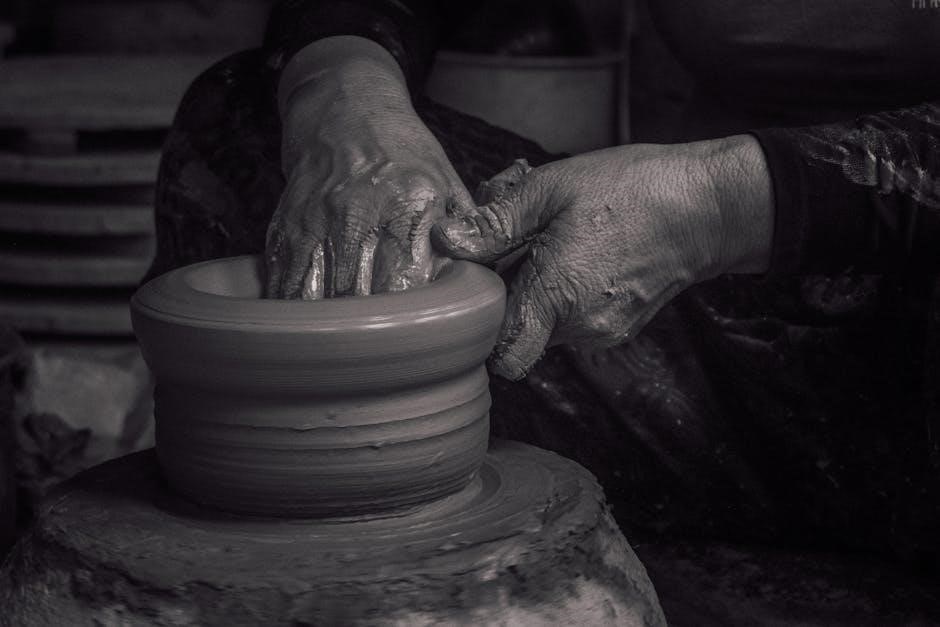
The Vermont Castings Encore manual provides essential guidance for installing, operating, and maintaining your stove. It ensures safe and efficient use, covering key features and troubleshooting.
1.1 Overview of the Vermont Castings Encore Stove
The Vermont Castings Encore stove is a high-efficiency, wood-burning heater designed for both non-catalytic and catalytic operation. Available in models such as the 2040 and 2550, it offers flexibility and reliability for home heating. The stove meets U.S. EPA emission standards, ensuring eco-friendly performance. With its durable construction and advanced combustion system, the Encore stove provides consistent heat output and minimal fuel consumption. The manual emphasizes proper installation, operation, and maintenance to optimize its performance and safety. Key features include adjustable air controls, a damper for airflow management, and a comprehensive warranty. The Encore stove is a versatile and efficient choice for homeowners seeking a dependable wood-burning solution. By following the manual’s guidelines, users can enjoy years of reliable service from this premium heating appliance.
1.2 Importance of the Manual for Safe Operation

The Vermont Castings Encore manual is crucial for ensuring safe and efficient operation of the stove. It provides detailed instructions on installation, operation, and maintenance, helping users avoid potential hazards. Failure to adhere to the manual’s guidelines can result in property damage or injury. The manual outlines essential safety precautions, such as proper venting, clearance requirements, and carbon monoxide safety measures. It also covers troubleshooting common issues, ensuring users can address problems effectively. By following the manual, users can maximize the stove’s performance while maintaining a safe environment. Regular maintenance tasks, like inspecting the chimney and cleaning the stove, are emphasized to prevent malfunctions. The manual serves as a comprehensive guide, empowering users to operate their Encore stove confidently and safely for years to come.

Key Features of the Vermont Castings Encore Stove
The Encore stove offers dual non-catalytic and catalytic burning options, high efficiency, and a comprehensive warranty. Its advanced design ensures optimal performance and durability for long-lasting use.
2.1 Non-Catalytic and Catalytic Burning Options
The Vermont Castings Encore stove features versatile non-catalytic and catalytic burning options, allowing users to choose between efficient, low-emission operation. The non-catalytic mode provides a robust fire, while the catalytic option enhances combustion efficiency, reducing emissions and maximizing heat output. This dual functionality ensures the stove adapts to different fuel types and burning preferences, making it suitable for various heating needs. The catalytic system includes a combustor that ignites gases and particulates at lower temperatures, ensuring cleaner burning. Regular maintenance of these components is crucial for optimal performance. The stove’s design seamlessly integrates both options, providing users with flexibility and control over their heating experience. This feature-rich system ensures efficient and environmentally friendly operation, catering to diverse user requirements and preferences.
2.2 High Efficiency and Performance
The Vermont Castings Encore stove is designed for high efficiency and performance, meeting strict EPA emission standards. Its advanced combustion system ensures optimal fuel utilization, producing consistent heat while minimizing emissions. The stove’s dual combustion technology allows for both non-catalytic and catalytic burning, enhancing efficiency and adaptability. With a robust construction and precision-engineered components, the Encore delivers reliable performance across various heating demands. Its efficient design ensures that heat is distributed evenly, providing warmth while maintaining low operational costs. The stove’s ability to maintain steady temperatures and reduce fuel consumption makes it a top choice for eco-conscious homeowners seeking both power and efficiency in a wood-burning appliance.
2.3 Comprehensive Warranty Coverage
Vermont Castings offers a Limited Lifetime Warranty on the Encore stove, covering castings, combustion systems, and door glass. This comprehensive coverage ensures long-term protection and peace of mind for homeowners. The warranty demonstrates the manufacturer’s confidence in the product’s durability and performance. Additional components are protected under a 5-year warranty, further enhancing the stove’s value. This extensive warranty program is designed to safeguard your investment, providing assurance against defects in materials and workmanship. With Vermont Castings, you can enjoy reliable heating performance knowing your stove is backed by one of the industry’s most robust warranty offerings. This commitment to quality and customer satisfaction makes the Encore stove a trusted choice for home heating needs.
Installation of the Vermont Castings Encore Stove
Proper installation ensures safety and efficiency. Follow the manual’s guidelines for venting, clearance, and assembly. Plan carefully to meet local codes and manufacturer recommendations for optimal performance.
3.1 Planning and Preparation for Installation
Planning and preparation are crucial for a successful installation. Begin by reviewing the manual to understand the process. Ensure the location meets clearance requirements and local building codes. Measure the space accurately to fit the stove and its components. Gather all necessary tools and materials listed in the manual. Check the chimney or venting system to ensure compatibility and proper sizing. Verify that the floor and surrounding areas are protected from heat damage. Consider hiring a qualified installer if unsure about any step. Proper preparation ensures a safe and efficient installation, adhering to both manufacturer guidelines and safety standards. This step lays the foundation for a trouble-free operation of your Vermont Castings Encore stove.
3.2 Step-by-Step Installation Instructions
Follow the manual’s step-by-step guide for proper installation. Begin by unpacking and inspecting all components for damage. Position the stove in the prepared location, ensuring it is level and meets clearance requirements. Connect the venting components, such as the flue collar and chimney adapter, securely. Install the chimney or venting system according to local codes and manufacturer specifications. Use approved materials for any necessary sealing or insulation. Once the stove is in place, connect it to the venting system and ensure all connections are tight. Finally, test the installation by lighting a small fire to check for proper draft and venting performance. Always follow the manual’s instructions precisely to ensure a safe and efficient setup.
3.3 Venting Requirements and Options
The Vermont Castings Encore stove requires proper venting to ensure safe and efficient operation. The stove features an 8-inch flue collar, which must be connected to a compatible venting system. It is approved for installation with a masonry chimney having a nominal flue size of 8×8 inches or 8×12 inches, or a round flue with a nominal diameter of 8 inches. The venting system must be installed according to local building codes and the manufacturer’s specifications. For optimal performance, the chimney should be tall enough to provide adequate draft. Additionally, the manual recommends using high-quality, heat-resistant venting components to ensure durability and safety. Proper venting is crucial for efficient combustion and to prevent potential hazards such as carbon monoxide buildup. Always refer to the manual for detailed venting configurations and recommendations.
3.4 Safety Considerations During Installation
Ensuring safety during the installation of the Vermont Castings Encore stove is paramount. Always follow the manufacturer’s guidelines and local building codes to prevent potential hazards. Maintain proper clearance from combustible materials, as specified in the manual, to reduce fire risks. The stove must be installed on a fire-resistant surface or hearth pad to protect against heat damage. Additionally, keep flammable materials away from the installation area. Ensure the stove is properly vented, as outlined in the venting requirements, to avoid carbon monoxide issues. Never attempt to modify the stove or venting system beyond the instructions provided, as this could compromise safety and void the warranty. Always disconnect the power supply before starting any installation work. If unsure about any step, consult a qualified installer or the manufacturer’s support team to ensure a safe and correct installation. Safety should never be compromised during the installation process.

Operating the Vermont Castings Encore Stove
Learn to operate the Vermont Castings Encore Stove efficiently, ensuring safe and optimal performance through proper fire management and air control adjustments with detailed guidance on fuel loading and burn techniques.
4.1 Starting and Maintaining the Fire
Starting and maintaining a fire in your Vermont Castings Encore Stove requires careful preparation and attention to detail; Begin by ensuring the stove is properly installed and vented, as outlined in the manual. Clear the area around the stove and open the damper fully before lighting the fire. Use dry, seasoned wood to ensure efficient combustion and minimize smoke. Light the fire with kindling and small logs, gradually adding larger pieces as the flames grow. Once the fire is burning steadily, adjust the air controls to optimize the burn rate and heat output. Regularly monitor the fire to ensure it burns cleanly and efficiently, and never leave it unattended. Proper maintenance, such as clearing ashes and inspecting the chimney, is essential for safe and consistent performance. Always follow the manual’s guidelines for fuel loading and burning techniques to maximize efficiency and safety.
4.2 Adjusting Air Controls for Optimal Burn
Adjusting the air controls on your Vermont Castings Encore Stove is crucial for achieving an optimal burn. The stove features a primary air control and a damper, both designed to regulate airflow and combustion efficiency. To start, fully open the primary air control to provide maximum oxygen for ignition. Once the fire is burning steadily, gradually reduce the airflow to maintain a consistent flame. The damper allows you to direct airflow within the stove, activating or deactivating the catalytic combustion system. For non-catalytic burning, keep the damper fully open, while for catalytic mode, close it slightly to engage the system. Regularly monitor the burn rate and adjust the controls as needed to ensure efficient combustion and minimize emissions. Proper adjustment ensures a clean, efficient fire, while also extending the life of your stove. Always refer to the manual for specific guidance on airflow management during different burning phases.
4.3 Proper Use of the Damper
The damper on your Vermont Castings Encore Stove plays a critical role in controlling airflow and combustion efficiency. It allows you to regulate how air flows through the stove, enabling you to switch between catalytic and non-catalytic burning modes. When the damper is fully open, it permits maximum airflow, ideal for starting and maintaining a robust fire in non-catalytic mode. For catalytic burning, close the damper slightly to direct air through the catalytic combustor, which enhances efficiency and reduces emissions. Always adjust the damper gradually to avoid sudden changes in airflow, which could disrupt the burn. Proper damper use ensures optimal performance, extends the stove’s lifespan, and minimizes creosote buildup. Regularly inspect and clean the damper to ensure smooth operation. Refer to the manual for specific damper settings tailored to your stove model and burning preferences.
4.4 Fuel Loading and Burning Techniques
Proper fuel loading and burning techniques are essential for maximizing the performance of your Vermont Castings Encore Stove. Always use seasoned hardwood, as it burns more efficiently and produces fewer emissions. Load the stove by placing larger logs at the bottom and smaller kindling on top to ensure a stable fire. For catalytic burning, fill the firebox to the recommended level to engage the combustor effectively. Avoid overloading, as this can restrict airflow and reduce efficiency. Maintain a moderate flame height for optimal heat output. When refueling, open the damper fully to ensure sufficient airflow for ignition. For non-catalytic mode, allow the fire to burn down to coals before adding more wood. Proper techniques ensure a clean, efficient burn and prolong the stove’s lifespan. Always follow the manual’s guidelines for fuel loading to achieve the best results.

Maintenance and Upkeep of the Encore Stove
Regular maintenance ensures optimal performance. Daily cleaning prevents residue buildup. Annual inspections of vents and components prevent wear. Follow the manual’s guidelines for safe and efficient operation.
5.1 Daily Maintenance Tasks
Daily maintenance is crucial for the Encore stove’s efficiency and safety. Begin by clearing ashes from the firebox using a shovel and storing them in a metal container. Ensure the firebox is free from debris before lighting a new fire. Check the glass doors for soot buildup and clean them with a damp cloth or stove glass cleaner to maintain visibility. Inspect the air controls and damper for proper function, ensuring they open and close smoothly. Additionally, monitor the chimney for any blockages or signs of wear. Regularly vacuum or sweep the surrounding area to prevent dust accumulation. Always refer to the manual for specific cleaning products and techniques to avoid damaging the stove’s surfaces. Consistent daily upkeep ensures reliable performance and prolongs the stove’s lifespan.
5.2 Weekly Cleaning and Inspection
Weekly cleaning and inspection are essential to maintain the Encore stove’s performance and safety. Start by allowing the stove to cool completely before beginning any maintenance. Remove ashes and debris from the firebox and ash pan, storing them in a fireproof container. Inspect the combustion chamber for creosote buildup and clean it with a wire brush if necessary. Check the baffle and catalytic combustor for damage or soot accumulation, cleaning them as needed. Examine the gaskets around the doors and glass for signs of wear, ensuring a tight seal. Clean the exterior surfaces with a mild soap solution to prevent rust. Additionally, inspect the chimney for blockages or damage, using a chimney brush if required. Always refer to the manual for specific cleaning instructions to avoid damaging components. Regular inspections help identify potential issues early, ensuring efficient and safe operation.
5.3 Annual Maintenance Requirements
Annual maintenance is crucial to ensure the Vermont Castings Encore stove operates efficiently and safely. At least once a year, hire a qualified technician to inspect the stove and chimney, focusing on the catalytic combustor and ventilation system. Clean or replace the catalytic combustor as needed, following the manual’s instructions. Inspect and clean the chimney thoroughly to remove creosote buildup and ensure proper draft. Additionally, check the stove’s exterior for signs of rust or damage and apply a high-temperature paint if necessary. Lubricate door hinges and seals to maintain a tight closure. Replace any worn-out gaskets or damaged components to prevent air leaks. Annual maintenance ensures optimal performance, safety, and longevity of the stove. Always refer to the manual for specific guidelines and recommendations tailored to your model.
5.4 Troubleshooting Common Issues
Troubleshooting common issues with the Vermont Castings Encore stove ensures optimal performance and safety. One frequent problem is draft issues, which can be resolved by checking venting connections and ensuring proper chimney clearance. If the stove isn’t igniting properly, inspect the air controls and clean the combustion system if necessary. Excessive smoke may indicate improper fuel loading or a blocked chimney, requiring immediate attention. For low heat output, check the damper settings and ensure the catalytic combustor is clean and functional. Refer to the manual for detailed troubleshooting steps tailored to your model. Regular maintenance and annual inspections can prevent many of these issues. Always follow the manufacturer’s guidelines for repairs and adjustments to ensure safety and efficiency. Proper troubleshooting ensures your stove operates effectively and remains a reliable heating source.

Safety Precautions and Guidelines
Follow all safety guidelines in the Vermont Castings Encore manual to ensure safe operation. Maintain proper clearance from flammable materials and keep the stove out of reach of children. Always monitor carbon monoxide levels and ensure proper ventilation. Regularly inspect the chimney and venting system for blockages or damage. Never leave a burning fire unattended, and store fuel in a dry, well-ventilated area. Adhere to local fire safety regulations and consult a professional for any installation or maintenance concerns. Proper safety practices will help prevent accidents and ensure efficient stove performance. Always prioritize safety to protect your home and family. Refer to the manual for detailed precautions and guidelines specific to your stove model. Stay informed and proactive to maintain a safe heating environment. By following these guidelines, you can enjoy the benefits of your Vermont Castings Encore stove while minimizing risks. Remember, safety should never be compromised when operating a wood-burning stove. Keep emergency contact information handy and ensure all household members understand basic safety protocols. Regular inspections and maintenance are crucial for maintaining safety standards. Never ignore unusual odors, sounds, or smoke, as they may indicate a potential hazard. Addressing issues promptly can prevent larger problems from developing. Safety is a shared responsibility between the user and the manufacturer, so stay vigilant and informed. The Vermont Castings Encore manual is your primary resource for ensuring safe and efficient stove operation. Use it wisely to protect your investment and your home. Always think ahead and plan for potential risks to avoid accidents. A safe stove is a well-maintained stove, so never skip routine checks. Your attention to safety details will pay off in the long run, providing peace of mind and reliable heating. Stay safe and enjoy the warmth of your Vermont Castings Encore stove.
6.1 Clearance Requirements for Safe Installation
Proper clearance is essential for the safe installation of your Vermont Castings Encore stove. Ensure the stove is installed at least 36 inches away from any combustible materials, such as walls, furniture, or curtains. Maintain a minimum clearance of 18 inches from the top and sides of the stove to any flammable objects. Always use a heat-resistant surface, like a hearth pad, to protect the floor from sparks or embers. Avoid placing the stove near flammable liquids, gases, or electrical appliances. Proper spacing ensures efficient airflow and reduces the risk of fire hazards. Follow the manufacturer’s guidelines for specific clearance requirements based on your stove model. Failure to maintain adequate clearance can lead to safety issues and void the warranty. Always consult the manual or a professional installer for precise measurements and compliance with local building codes. Proper clearance is crucial for safe and efficient stove operation.
6.2 Importance of Chimney Maintenance
Regular chimney maintenance is vital for the safe and efficient operation of your Vermont Castings Encore stove. A well-maintained chimney ensures proper ventilation, reducing the risk of carbon monoxide buildup and chimney fires. Inspect the chimney annually for creosote buildup, cracks, or damage. Clean the chimney before each heating season to remove soot and debris that can obstruct airflow. Ensure the chimney is the correct size and height for your stove, as specified in the manual. A damaged or improperly maintained chimney can lead to dangerous conditions, including poor draft and reduced stove performance. Always use a qualified professional for inspections and repairs. Proper chimney maintenance not only enhances safety but also prolongs the lifespan of your stove and ensures optimal heating efficiency. Refer to the manual for detailed guidelines on chimney care and maintenance requirements. Regular upkeep is essential for a safe and efficient heating system.
6.3 Carbon Monoxide Safety Measures

Carbon monoxide (CO) safety is crucial when operating the Vermont Castings Encore stove. CO is a colorless, odorless gas that can be deadly in high concentrations. Proper installation, maintenance, and operation of your stove are essential to minimize CO risks. Ensure the chimney and venting system are free from blockages, such as creosote buildup or debris, as these can disrupt airflow and lead to CO accumulation. Regular inspections of the chimney and venting system are mandatory. Install CO detectors on every level of your home and near sleeping areas for early warning. Never operate the stove if the chimney is blocked or if there are signs of CO leakage. Always follow the manual’s guidelines for proper stove operation and ventilation. CO safety measures are non-negotiable to protect you and your family from potential hazards. Stay vigilant and proactive in maintaining a safe environment for your stove’s use.

Common Issues and Solutions
Common issues with the Vermont Castings Encore include draft problems, ignition difficulties, and inconsistent burning. Solutions involve adjusting air controls, ensuring proper venting, and regular maintenance.

7.1 Addressing Draft Problems
Draft problems in the Vermont Castings Encore can hinder performance. Ensure proper venting by checking chimney connections and flue size. Clean or replace damaged components and inspect for blockages. Regular maintenance, like clearing creosote buildup, is crucial. Adjusting the damper and air controls can also improve airflow. If issues persist, consult a professional to assess and resolve ventilation system flaws.
7.2 Solving Ignition and Burning Issues
Ignition and burning issues with the Vermont Castings Encore can often be resolved by ensuring proper airflow and fuel quality. Check that the wood is dry and seasoned, as moisturecontent can hinder combustion. Verify that the chimney and vents are clear of obstructions, such as creosote buildup or debris. Adjust the damper and primary air control to optimize oxygen flow for a robust flame. If the stove struggles to light, inspect the ignition system and ensure all components are functioning correctly. Regular cleaning of the combustion chamber and air passages is essential to maintain efficient burning. For persistent problems, consult the troubleshooting section of the manual or contact a certified technician for assistance.
8.1 Final Thoughts on the Vermont Castings Encore Manual

The Vermont Castings Encore manual is a comprehensive guide ensuring safe and efficient stove operation. Adhere to its instructions for optimal performance and troubleshooting.
The Vermont Castings Encore manual serves as a vital resource for users, offering detailed instructions for installation, operation, and maintenance. It emphasizes safety and efficiency, ensuring optimal performance while adhering to environmental standards. By following the manual’s guidelines, users can troubleshoot common issues and extend the stove’s lifespan. The comprehensive warranty and customer support further enhance the user experience. This manual is indispensable for anyone aiming to maximize their stove’s potential while ensuring safe and reliable operation. Refer to it regularly to maintain your Encore stove’s peak performance and enjoy the benefits of a well-functioning heating system.